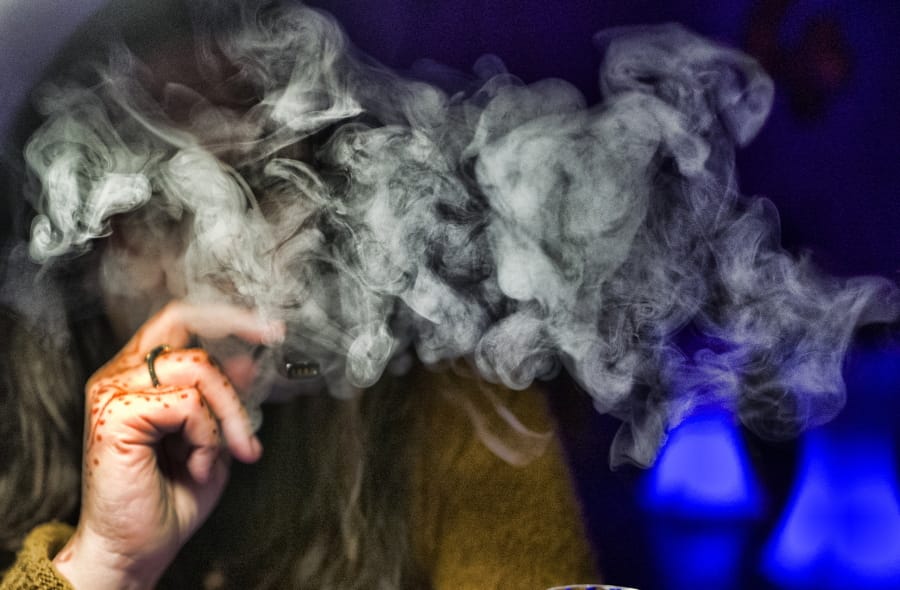As more states legalize marijuana, the number of adult consumers has been on the rise. But there are only three major metro areas where cannabis is more popular than cigarettes and other products containing nicotine, according to new market-research data.
And — you guessed it — Seattle is one of them.
More than 700,000 people age 18 and older in the Seattle-Tacoma area — about 17 percent of the adult population — have consumed cannabis in the past 30 days, according to the data from the market-research firm Nielsen. That’s the fourth highest consumption among 70 large metro areas, behind Portland, Las Vegas and Denver. And it edges out the use of nicotine products, including cigarettes other tobacco products and e-cigarettes. Combined, they were consumed by about 16 percent of adults in our metro area.
The other two metros where cannabis is more popular than nicotine are probably not much of a surprise: San Francisco and Portland.
What these areas have in common is, when compared to the national average, a high percentage of cannabis consumers and a low percentage of nicotine consumers. Portland has the nation’s highest share of adult cannabis consumers, at 20 percent — that’s about 1 percentage point higher than nicotine consumers.
What about other areas where marijuana is very popular, like Denver? About 18 percent in the Mile High City say they’ve consumed cannabis in the past 30 days, which is just a tad lower than the 19 percent for cigarettes and other nicotine products. In Las Vegas, 18 percent consumed cannabis compared with 23 percent who consumed nicotine.
Nielsen surveyed more than 200,000 adults nationally, including about 4,000 in the Seattle-Tacoma area from January 2018 to May 2019. The survey does not ask people if they acquired the cannabis product through the legal sector or through the black market.
California became the first state to legalize the medical use of marijuana in 1996. In 2012, Washington and Colorado became the first to legalize recreational use. Nine more states (plus the District of Columbia) have since legalized recreational use: Alaska, California, Illinois, Maine, Massachusetts, Michigan, Nevada, Oregon and Vermont. Another 22 states have legalized cannabis for medical use only. Polling shows a clear majority of Americans support legal marijuana.
As you’d probably expect, the highest use of cannabis is in metro areas that, like Seattle, are located in states that have adopted the most expansive legalization laws. The Albuquerque-Santa Fe area has the highest share of cannabis consumers in a metro where recreational use is prohibited by state law. At 14 percent of the adult population, it ranks 8th among the 70 metro areas, and higher than some where recreational use is allowed, including Spokane (12 percent).
The market research shows that adults in the Seattle area who consume cannabis have a median household income of about $78,000, significantly higher than e-cigarettes vapers ($67,000) and those who smoke cigarettes or use other tobacco products ($59,000). Cannabis consumers are also a lot more likely to be college graduates than the other two groups.
Seattle cannabis consumers have a median age of 40, somewhat younger than tobacco users (44 years). But e-cigarettes appeal to the youngest demographic, with a median age of just 31. E-cigarettes, which are used for vaping, contain nicotine but no tobacco.
Men are a little more likely than women to consume either cannabis or nicotine products, though vaping comes closest to gender parity.
Slightly more than one quarter of cannabis consumers in the Seattle area are people of color, compared with 30 percent of tobacco consumers. E-cigarette consumers are far more diverse — 41 percent of adults who vape are people of color.
Unsurprisingly, when it comes to mood-altering substances, neither cannabis nor nicotine can touch alcohol in popularity.
The research shows nearly half (48 percent) of adults in the Seattle area ingested some type of alcohol — and that’s just within the past seven days.
——
(C)2019 The Seattle Times
Visit The Seattle Times at www.seattletimes.com
Distributed by Tribune Content Agency, LLC.



